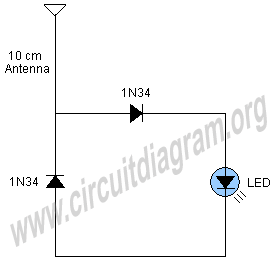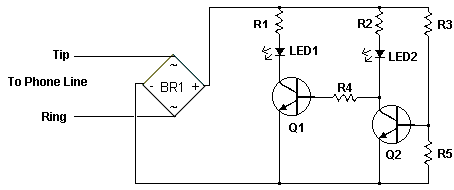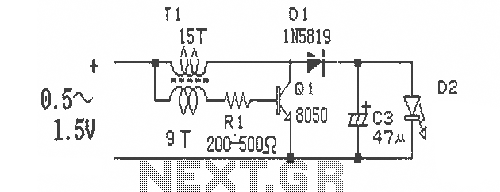
cell phone signal activated led

A simple and interesting project schematic for a cell phone signal-activated LED circuit. The circuit will illuminate an LED when a call is made from a cell phone.
This cell phone signal-activated LED circuit utilizes a basic principle of detecting the radio frequency (RF) signals emitted by a mobile phone during an incoming call. The circuit typically consists of a few essential components: an RF receiver module, a microcontroller or a transistor for signal processing, and an LED for visual indication.
The RF receiver module is designed to pick up the specific frequency that mobile phones operate on. When a call is initiated, the RF receiver detects the signal and generates a corresponding output. This output can be used to trigger a transistor or microcontroller, which acts as a switch to control the LED.
The LED is connected in series with a current-limiting resistor to prevent excess current from damaging it. When the RF receiver detects the incoming call signal, it activates the transistor or microcontroller, allowing current to flow through the LED, thus lighting it up.
Power for the circuit can be supplied from a battery or an external power source, depending on the design requirements. Proper grounding and circuit protection should also be considered to ensure the reliability and longevity of the circuit.
This project serves as an excellent introduction to basic electronics and RF signal detection, demonstrating how everyday technology can be integrated into simple electronic circuits.A very simple and interesting project / schematic of a cell phone signal activated LED circuit. The circuit will light up an led when you call from your cell phone.. 🔗 External reference
This cell phone signal-activated LED circuit utilizes a basic principle of detecting the radio frequency (RF) signals emitted by a mobile phone during an incoming call. The circuit typically consists of a few essential components: an RF receiver module, a microcontroller or a transistor for signal processing, and an LED for visual indication.
The RF receiver module is designed to pick up the specific frequency that mobile phones operate on. When a call is initiated, the RF receiver detects the signal and generates a corresponding output. This output can be used to trigger a transistor or microcontroller, which acts as a switch to control the LED.
The LED is connected in series with a current-limiting resistor to prevent excess current from damaging it. When the RF receiver detects the incoming call signal, it activates the transistor or microcontroller, allowing current to flow through the LED, thus lighting it up.
Power for the circuit can be supplied from a battery or an external power source, depending on the design requirements. Proper grounding and circuit protection should also be considered to ensure the reliability and longevity of the circuit.
This project serves as an excellent introduction to basic electronics and RF signal detection, demonstrating how everyday technology can be integrated into simple electronic circuits.A very simple and interesting project / schematic of a cell phone signal activated LED circuit. The circuit will light up an led when you call from your cell phone.. 🔗 External reference
Warning: include(partials/cookie-banner.php): Failed to open stream: Permission denied in /var/www/html/nextgr/view-circuit.php on line 713
Warning: include(): Failed opening 'partials/cookie-banner.php' for inclusion (include_path='.:/usr/share/php') in /var/www/html/nextgr/view-circuit.php on line 713





